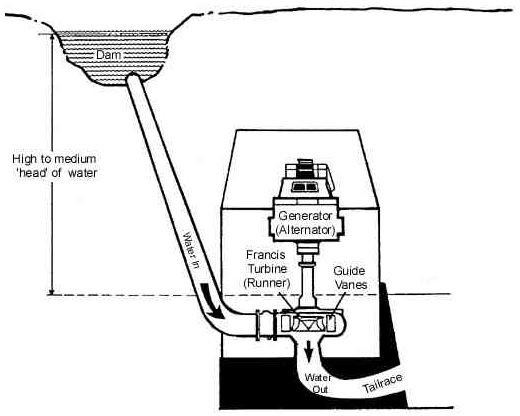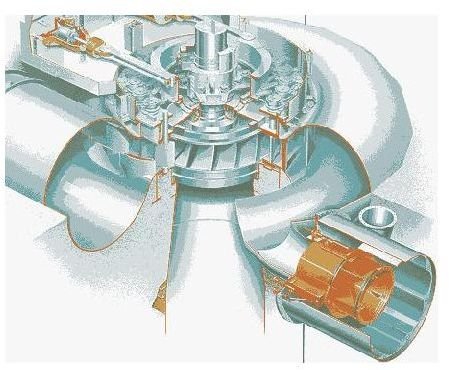What is Francis Turbine? How Francis Turbine Works? Types of Hydraulic Turbines
Francis Turbine is the first hydraulic turbine with radial inflow. It was designed by American scientist James Francis. Francis Turbine is a reaction turbine. Reaction Turbines have some primary features which differentiate them from Impulse Turbines. The major part of pressure drop occurs in the turbine itself, unlike the impulse turbine where complete pressure drop takes place up to the entry point and the turbine passage is completely filled by the water flow during the operation.
Design of Francis Turbine
Francis Turbine has a circular plate fixed to the rotating shaft perpendicular to its surface and passing through its center. This circular plate has curved channels on it; the plate with channels is collectively called as runner. The runner is encircled by a ring of stationary channels called as guide vanes. Guide vanes are housed in a spiral casing called as volute. The exit of the Francis turbine is at the center of the runner plate. There is a draft tube attached to the central exit of the runner. The design parameters such as, radius of the runner, curvature of channel, angle of vanes and the size of the turbine as whole depend on the available head and type of application altogether.
Working of Francis Turbine
Francis Turbines are generally installed with their axis vertical. Water with high head (pressure) enters the turbine through the spiral casing surrounding the guide vanes. The water looses a part of its pressure in the volute (spiral casing) to maintain its speed. Then water passes through guide vanes where it is directed to strike the blades on the runner at optimum angles. As the water flows through the runner its pressure and angular momentum reduces. This reduction imparts reaction on the runner and power is transferred to the turbine shaft.
If the turbine is operating at the design conditions the water leaves the runner in axial direction. Water exits the turbine through the draft tube, which acts as a diffuser and reduces the exit velocity of the flow to recover maximum energy from the flowing water.
Power Generation using Francis Turbine

For power generation using Francis Turbine the turbine is supplied with high pressure water which enters the turbine with radial inflow and leaves the turbine axially through the draft tube. The energy from water flow is transferred to the shaft of the turbine in form of torque and rotation. The turbine shaft is coupled with dynamos or alternators for power generation. For quality power generation speed of turbine should be maintained constant despite the changing loads. To maintain the runner speed constant even in reduced load condition the water flow rate is reduced by changing the guide vanes angle.
This post is part of the series: Hydraulic Turbines
Hydraulic Turbines transfer the energy from a flowing fluid to a rotating shaft. Turbine itself means a thing which rotates or spins. To know more about what are Hydraulic Turbines, what is the working principle of Hydraulic Turbines and how are they classified, read on through this article series.
